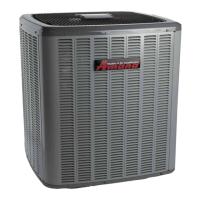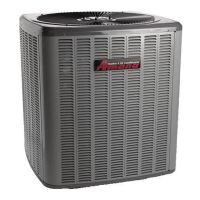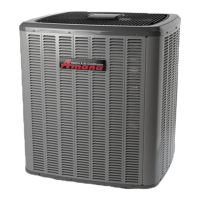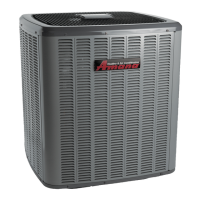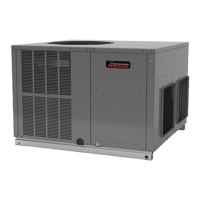SERVICING
51
The expansion valves are factory adjusted to maintain 7 to
9 degrees superheat of the suction gas. Before checking
the superheat or replacing the valve, perform all the
procedures outlined under Air Flow, Refrigerant Charge,
Expansion Valve - Overfeeding, Underfeeding. These are
the most common causes for evaporator malfunction.
Refrigerant gas is considered superheated when its
temperature is higher than the saturation temperature
corresponding to its pressure. The degree of superheat
equals the degrees of temperature increase above
the saturation temperature at existing pressure. See
Temperature - Pressure Chart on following pages.
1. Run system at least 10 minutes to allow pressure to
stabilize.
2. For best results, temporarily install a thermometer on
the liquid line at the liquid line service valve and 4-6”
from the compressor on the suction line. Ensure the
thermometer makes adequate contact and is insulated
for best possible readings. Use liquid line temperature
to determine sub-cooling and vapor temperature to
determine superheat.
3. Refer to the superheat table provided for proper system
superheat. Add charge to lower superheat or recover
charge to raise superheat.
Superheat Formula = Suct. Line Temp. - Sat. Suct. Temp.
EXAMPLE:
A. Suction Pressure = 143
B. Corresponding Temp. °F. = 50
C. Thermometer on Suction Line = 61°F.
To obtain the degrees temperature of superheat, subtract
50.0 from 61.0°F.
The dierence is 11° Superheat. The 11° Superheat would
fall in the ± range of allowable superheat.
4. Disconnect manifold set, installation is complete.
SUBCOOLING FORMULA = SATURATED LIQUID TEMP.
- LIQUID LINE TEMP.
HEAT PUMP - HEATING CYCLE
The proper method of charging a heat pump in the heat
mode is by weight with the additional charge adjustments
for line size, line length, and other system components.
For best results on outdoor units with TXVs, superheat
should be 2-5°F at 4-6” from the compressor. Make nal
charge adjustments in the cooling cycle.
The reason for compressor ineciency is broken or
damaged scroll anks on Scroll compressors, reducing the
ability of the compressor to pump refrigerant vapor.
The condition of the scroll anks is checked in the following
manner:
1. Attach gauges to the high and low side of the system.
2. Start the system and run a “Cooling Performance Test.
If the test shows:
A. Below normal high side pressure.
B. Above normal low side pressure.
C. Low temperature dierence across coil.
D. Low amp draw at compressor.
And the charge is correct. The compressor is faulty -
replace the compressor.
Overfeeding by the expansion valve results in high suction
pressure, cold suction line, and possible liquid slugging of
the compressor.
If these symptoms are observed:
1. Check for an overcharged unit by referring to the
cooling performance charts in the servicing section.
2. Check the operation of the power element in the valve
as explained in Checking Expansion Valve Operation.
3. Check for restricted or plugged equalizer tube.
Underfeeding by the expansion valve results in low system
capacity and low suction pressures.
If these symptoms are observed:
1. Check for a restricted liquid line or drier. A restriction
will be indicated by a temperature drop across the drier.
2. Check the operation of the power element of the valve
as described in Checking Expansion Valve Operation.
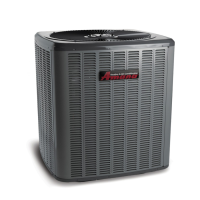
